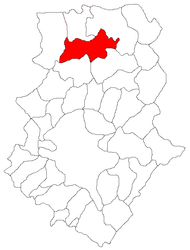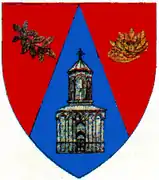Snagov
Snagov (population: 6,041) is a commune, located 40 km north of Bucharest in Ilfov County, Muntenia, Romania. According to the 2002 census, 99.2% of the population is ethnic Romanian. The commune is composed of five villages: Ciofliceni, Ghermănești, Snagov, Tâncăbești and Vlădiceasca. Snagov is a tourist and spa resort, but the necessary infrastructure has regressed after 1989.
Snagov | |
|---|---|
.jpg.webp) Snagov Monastery | |
 Location in Ilfov County | |
 Snagov Location in Romania | |
| Coordinates: 44°42′32″N 26°10′17″E | |
| Country | |
| County | Ilfov |
| Population (2011)[1] | 7,272 |
| Time zone | EET/EEST (UTC+2/+3) |
| Vehicle reg. | IF |
Name
The Snagov name is of probably Bulgarian origin, from the word sneg (meaning "snow") or snaga, meaning "human body".
Geography
Snagov is located on the Romanian plain, on the shore of Lake Snagov (biggest natural lake in Romania: 600 sq ha, 16 km long) which is still partially surrounded by old oak forest (remains of Codrii Vlăsia).
History/early Medieval history/feudal estate/modern settlement
Archaeologists confirmed human presence of inhabitants since 400 BC. Snagov village was built around Lake Snagov and Snagov monastery, founded in the late 14th century on an islet in Lake Snagov, about 2 km north of Snagov village. The first written record of it is found in a document from the court of Mircea cel Bătrân and dated 1408. Snagov monastery was excavated in 1933 by archaeologist Dinu V. Rosetti.[2]
Tourism
Cultural attractions include the Snagov monastery, Snagov Palace, several monuments, the Snagov Museum, a set of four local traditions (fishing, braiding of vegetable fibers, pottery, traditional fabrics).
Natural attractions are associated with two protected natural areas, Snagov Lake (100–150 ha) and Snagov Forest (10 ha), which are included in the Snagov Natural Complex Reserve. With an area of 1,147.7 ha, the nature reserve was established in 1952 and includes all the forests on the shore of the lake.
Also in Snagov one can find a Tourist Information Center, a Rental Center (bicycles, kayaks), a Biodiversity Center, and a site with the entire Snagov Eco-tourism Offer (attractions, activities, circuits, audio guides, etc.)
Events
- 25 June 1933: The National Celebration of Water day, with King Carol II, Michael I, Nicolae Iorga, Iuliu Maniu, Dimitrie Gusti and many other top officials, as well as Liga Navală Română, Cercetașii României and representatives of the local community in attendance. This is the reason for celebrating the day of Lake Snagov on June 25, when Romanians also celebrate "Sânzienele/Drăgaica".
- 23 August 1944: Ion Antonescu left Snagov Palace in order to go to Bucharest at the request of King Michael I, where he was arrested during the King Michael's Coup. Manfred von Killinger, who was also staying at a nearby villa on the shore of Lake Snagov, committed suicide soon after, because he failed to maintain Romania on the side of Nazi Germany, as requested by Hitler.
- 1962 to 1972: Regata Snagov was an international rowing competition held between 1962 and 1972.
- 2002: The Romanian government decided to build at Snagov a Disneyland-style theme park, called "Dracula Park"; the project was canceled in 2006. The connection with "Dracula" is due to a spurious 19th-century tradition which makes Snagov monastery the site of the tomb of Vlad the Impaler.
- 4–5 April 2003: An informal meeting of the prime ministers of the seven states invited to join the NATO alliance was held at Snagov Palace.
- 2008: A pedestrian footbridge was struck by a tipper lorry, which was lifted and then collapsed onto a moving car, killing a 21-year old woman driving towards Bucharest. The footbridge has not been rebuilt since then, and the stairways were left as a memorial to the death of the victim, but they are also pending reconstruction.
- 2016: Protection of the natural area (heritage) was reinforced by "The management plan and the ANPLS regulation" published in the Official Gazette.
Notable people
Romanian president Nicolae Ceaușescu and his entourage used Snagov as a vacation retreat. Over 50 heads of state, prime ministers, top politicians from more than 40 states, walked on lake Snagov with the "Snagov 1" luxury boat (today called "Leader"). In Snagov at the film studios Castel Film Romania, over 250 films were produced. In the Snagov Museum, collections are presented about 130 personalities related to Snagov.
Twin towns/sister cities
Initiated but not yet implemented - with: Port of Le Havre from France and Sarkad from Hungary, Gandiaye village from Senegal.
Notable sites
.jpg.webp)
.jpg.webp)
- Siliștea Snagovului, a church built in 1664.
- The Imre Nagy monument. The prime minister of Hungary was kept for a few months in Snagov before being sent to trial and executed in Budapest.
- Stadionul Snagov, a football stadium seating 2,000.
- Near Tâncăbești, there is since 1949 a medium wave broadcasting station, which uses as antenna a 187 meters tall guyed mast radiator. Tâncăbeşti transmitter, which works on 855 kHz used before the 1990s a transmission power of 1500 kW. Today it may be 300 kW.
External links
References
- "Populaţia stabilă pe judeţe, municipii, oraşe şi localităti componenete la RPL_2011" (in Romanian). National Institute of Statistics. Retrieved 4 February 2014.
- Dinu V. Rosetti, Săpăturile Arheologice de la Snagov (1935).
